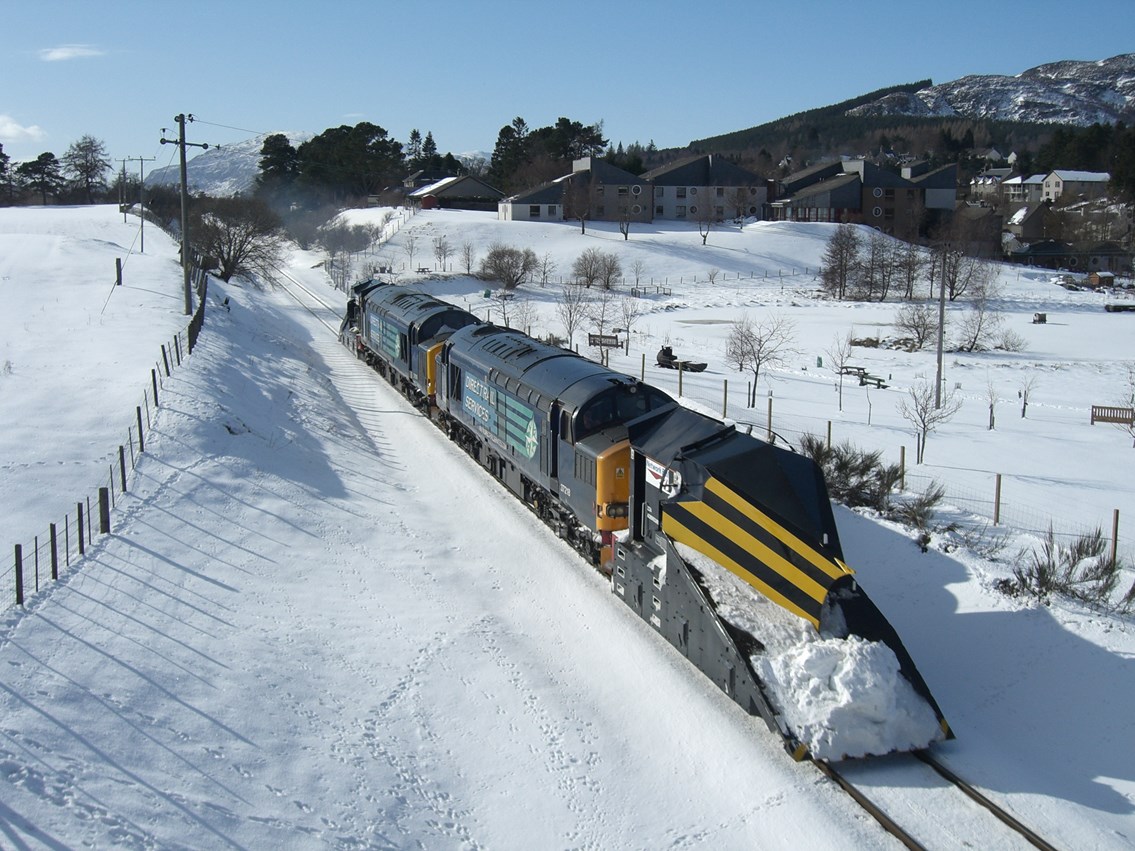Wednesday 16 Jan 2019
With temperatures dropping across Britain the rail industry is gearing up for winter weather
- Region & Route:
- National
Just like road and air travel, wintry weather can pose challenges for the rail network, with its effects ranging from speed restrictions on exposed routes, to services being suspended due to avalanches.
High winds can blow objects on to the line and heavy rain can cause flooding and landslips, which means trains must stop until the line is cleared, and a thorough safety inspection of the track is carried out.
Low temperatures can also cause points, movable sections of track that trains to move from one line to another, to freeze up, preventing trains from accessing certain routes or platforms.
To help keep passengers moving, Network Rail operates a special winter fleet – complete with snowploughs, hot air blowers, steam jets, brushes, scrapers and anti-freeze – to clear snow and ice from the tracks and has fitted over 100km of special heating strips to prevent ice building up on conductor rails which power trains in the south and south east of England.
Network Rail and the wider rail industry’s winter preparation programme includes a number of measures:
- 10 snow and ice treatment trains (SITTs) fitted with snowploughs, hot air blowers, steam jets, brushes, scrapers and jets for heated anti-freeze and compressed air to quickly de-ice tracks
- 12 independent snow plough locomotives to clear deep snow from the tracks, as well as a number of mid-range ploughs
- We've attached heaters and NASA-grade insulation to points to prevent ice forming and added protective covers to 4,000 points and 2,500 points motors to keep snow out and prevent damage by ice falling from trains
- Thousands of our people patrol the tracks day and night clearing snow and ice from junctions and tunnels
- Our remote temperature monitoring and a helicopter fitted with thermal imaging cameras identify points heaters that are not working effectively
- Anti-icing fluid and heating strips are used on live conductor rails to prevent ice building up and preventing trains from drawing power; the addition of heating strips has reduced ice-related incidents by up to 80%
- Train companies run empty trains through the night to help keep tracks clear, and passenger trains can be fitted with snow ploughs which can clear up to eight inches of snow – if it's deeper, we send in our fleet of dedicated snowploughs
- Major routes that are the most at risk have been fitted with fences that prevent snow blowing on to the tracks
- We use ballast – the stones beneath the track – treated with anti-icing fluid for our winter engineering work, as this stops it freezing together in the delivery wagons and helps us to continue working in all temperatures.
Detailed forecasts from weather experts MetDesk are used by Network Rail to formulate local action plans during adverse weather to minimise disruption to passengers. The forecasts cover not just the weather but how the conditions will impact on specific railway infrastructure such as the tracks, conductor rails and overhead power lines. A network of hundreds of monitoring stations also provides real-time weather data, enabling Network Rail to respond to conditions as they develop in real time.
Network Rail’s winter preparedness regime begins in September each year. Special trains and equipment are fully checked and any repairs carried out, while contingency plans are reviewed and agreed with train operators to keep passengers moving during adverse weather.
Andy Thomas, managing director of strategic operations at Network Rail said: “We work closely with train operators to minimise any impact on passenger services during winter weather such as snow and ice. Key sections of track are fitted with heaters and insulation to help stop them freezing, and empty trains can be run through the night to help keep tracks clear. We have extra teams of people on the ground to respond to incidents and carry out regular inspections of our infrastructure.
“When conditions are very serious, trains might have to slow down – just as a car would on a road – this is so everyone can get where they need to go, safely.”
To find out more about how Network Rail gears up for winter, go to: www.networkrail.co.uk/winter.
NOTES:
- For more information on how we keep trains moving in snow and ice visit - https://www.networkrail.co.uk/feeds/keeping-trains-moving-snow-ice/
- Delays explained – snow and ice: https://www.networkrail.co.uk/running-the-railway/looking-after-the-railway/delays-explained/snow-and-ice/
- For pictures of our cold weather vehicles and frontline workforce in action visit - https://www.networkrailmediacentre.co.uk/resources?SearchString=snow
Contact information
Passengers / community members
Network Rail national helpline
03457 11 41 41
Latest travel advice
Please visit National Rail Enquiries
Journalists
Network Rail press office -Grete Luxbacher
Senior media relations manager
Network Rail
020 3356 8700
07710 959721
grete.gogay@networkrail.co.uk
About Network Rail
We own, operate and develop Britain's railway infrastructure; that's 20,000 miles of track, 30,000 bridges, tunnels and viaducts and the thousands of signals, level crossings and stations. We run 20 of the UK's largest stations while all the others, over 2,500, are run by the country's train operating companies.
Usually, there are almost five million journeys made in the UK and over 600 freight trains run on the network. People depend on Britain's railway for their daily commute, to visit friends and loved ones and to get them home safe every day. Our role is to deliver a safe and reliable railway, so we carefully manage and deliver thousands of projects every year that form part of the multi-billion pound Railway Upgrade Plan, to grow and expand the nation's railway network to respond to the tremendous growth and demand the railway has experienced - a doubling of passenger journeys over the past 20 years.
Follow us on Twitter: @networkrail
Visit our online newsroom: www.networkrailmediacentre.co.uk

